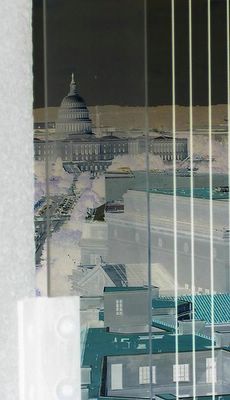The Washington Post sparked discussions across the capital Monday about the considerable burden the tourist classes place on locals who are trying to simply move about town quickly via public transportation. The problem:
outsiders standing on the left side of Metrorails's 572 escalators.
From the
Post's Lyndsey Layton:
Here comes Sarah Shain, typical Metro rider. The 22-year-old District resident is hustling down the left side of the escalator to the lower platform at Metro Center, clacking on the moving metal steps in her sensible pumps, until she hits a roadblock: a pair of tanned tourists in shorts standing two abreast, talking and blocking her path to the Orange Line train idling at the bottom of the escalator.
The Washington Metropolitan Area Transit Authority, which runs Metrorail, doesn't support climbing escalators, because it can be dangerous. In fact, WMATA escalator run at speeds slower than escalators in a typical shopping center.
The conflict is most visible on Metro's 572 escalators. Because the subway was built deep beneath swampy Washington, Metro has more escalators than any other transit system in the world. A typical passenger must ride at least two escalators to reach a train. The steps are 40 inches wide, broad enough for just two adults.
(Hold on Lyndsey, "swampy Washington"? More on that in a second.)
That means that riding the Wheaton escalator can take three minutes; and the Dupont Circle Metro's 2 minutes and 10 seconds. The escalator at Woodley Park Zoo/Adams Morgan, a favorite of tourists with small children, clocks in at 2 minutes and 20 seconds.
And that means that the average Washington commuter will walk up the escalator, which could potentially lead to a fall. WMATA will not encourage walking on the left, though they won't go out of their way to tell people to move to the right.
Last year, they tried, sort of.
As you may remember, WMATA placed yellow message signs on the ground of many Metrorail stations, telling people not to run in the stations, to stand back from the platform edge, and one, if I remember correctly, said stand on the right of escalators. Though the signs worked their way into my subconscious, I think they disappeared. They may still be there, but I don't think they are.
In London, the Underground has signs in certain stations, particularly at newer facilities on the
Jubilee Line that tell commuters to stand on the right of escalators. Granted, tort reform may farther advanced in the United Kingdom than in the United States, but still, is WMATA afraid of lawsuits from a lawsuit happy society that could pounce on the cash-strapped agency if someone falls and chips a front tooth? That is the impression that I got when I dealt with the agency. It wasn't a territory they wanted to cross into.
So in the meantime, locals can complain, and even
buy a t-shirt from some budding entrepreneurs to vent their frustration with the tourist classes.
Swampy Washington? In Layton's report, she writes that escalators are so deep because of Washington's "swampy" nature. Hmmm. That isn't really true at all. It you might notice, the deepest stations in the system lie below Connecticut and Wisconsin avenues in "Upper" Northwest. For instance, in order for the Red Line to travel beneath the Rock Creek gorge, it must dive deep underground. In fact, the Red Line tunnel beneath Kalorama and Woodley Park was only feasible by building one tunnel, not the dual parallel tubes common in the rest of the system. (Therefore, the Woodley Park station is deep beneath Connecticut Avenue. The last time I checked, Woodley Park sits high on a bluff above Rock Creek, not on a swampy tidal flat.)
The only subway tunnels built through areas that were once swampy are mainly down near the Mall. As you may know, the entire Mall west of 17th Street is built on drained river marshes, as is the Constitution Avenue corridor, which is built on the former Tiber Creek. So the Smithsonian metrorail station, and other stations close to sea level are actually among the most shallow underground stations in the system.
WMATA Watch. DC SOB on Monday
celebrated the completion of the repairs to the Judiciary Square escalators at the D Street exit, naming the winner of his contest to pinpoint the date of completion. This contest is a symbol of all of our frustrations with WMATA's escalator problem.
They are technically among the most complicated escalator contraptions in the world and there are a lot of them (572 according to the
Post). It would make sense that if WMATA built an escalator-dependent system, the agency would know how to maintain them. Some blame the unions, some blame the escalators' exposure to the elements, some blame basic agency befuddlement.
So it may be good to remind WMATA of their problems. As public citizens, we are the eyes and ears for WMATA. So here, "WMATA Watch" is launched. I will keep track of WMATA service failures in this space and compile reports from time to time on interesting trends I notice.
First up: Dupont Circle metrorail station, 8:00 p.m., Monday, May 17, 2004 ... Station manager announced that all three escalators at the 19th Street portal were not working.
In a related note at Dupont. The elevator is out of service for major capital rehabilitation. The suggested alternative is Farragut North. But unless you know of the outage in advance and have mobility difficulties, you wouldn't know of the outage until Dupont Circle, when during the normal station announcement by the train operator, it is made known that the elevator is out of service. For Shady Grove-bound trains, it would make more sense to announce the Dupont outage at Farragut North.
Have a WMATA Watch tip? E-mail the
Oculus at
oculus [at] fastmail.fm


